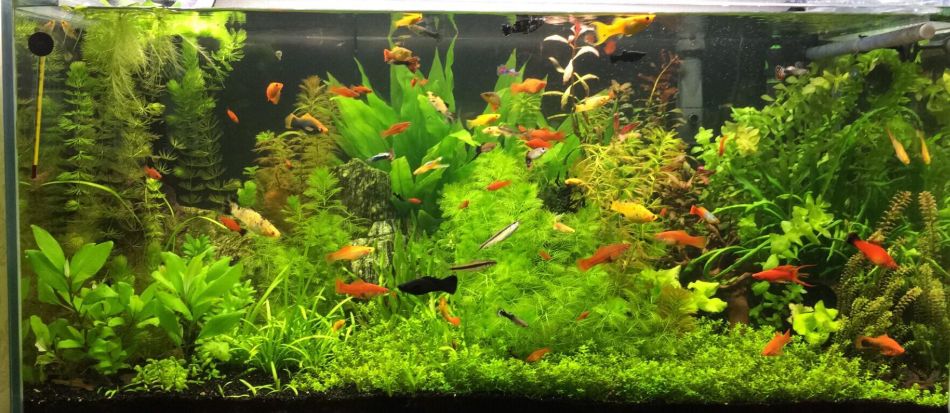
There are as many good ways to set up a planted aquarium as there are good ways to set up a fish only aquarium. But surprisingly plants are more difficult than fish are. Growing lush plants can be tricky. Growing lush plants without growing lush algae can also be challenging. And adding large numbers of sizable fish to the equation is normally a significant challenge.
If one really wants plants with their fish there are some plants which are the exception and simply can’t be killed and which seem to live under any and all conditions. While they will get some algae on their leaves the leaves are resistant to being smothered by algae. And they seem to live in under all conditions with no fertilizer at all. They even live with very low light conditions.
Warning: This is a very long and boring dissertation only for those who are nerds like the author.
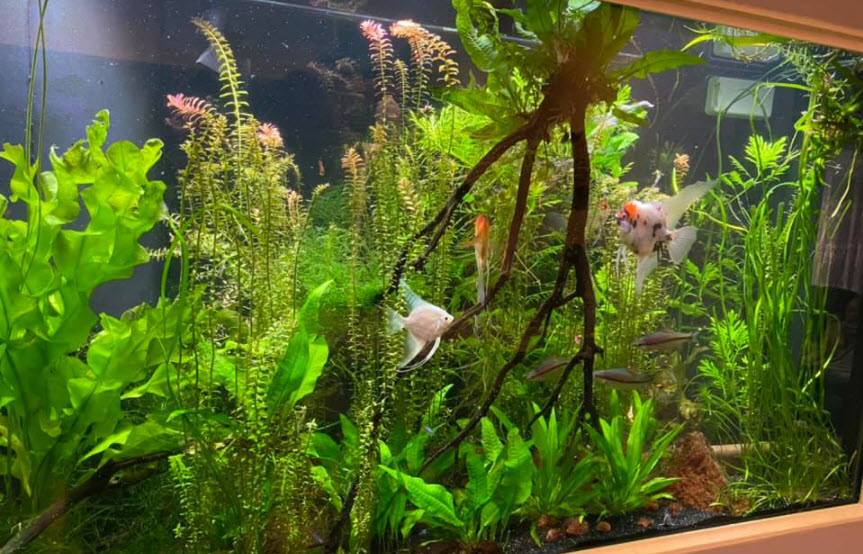
Recommended Number of Fish in a Planted Aquarium
There are several very general, frequently not followed, recommendations for a planted aquarium:
- Light stocking of fish smaller than two inches
- A carbon dioxide (“CO2”) level above 10 ppm first thing in the morning
- A plant every three inches across both the length and the width of the aquarium
- Little surface movement of the water and no air stones
- Slowly ramp up light and CO2 over a span of months.
The thing to key in on is the first recommendation: light stocking of fish smaller than two inches. This is where most hobbyists make their mistake.

It is very difficult to have a well planted tank with a lot of sizable fish. The fish require aeration to do well, and the plants do not like aeration as it depletes the water of the carbon dioxide the plants require. One can have a planted aquarium with a lot of decent sized fish but it is challenging.
The following is a low tech planted tank with a large stocking of Lake Malawi cichlids. This aquarium had been growing plants for a year and a half when it was photographed. The substrate is simply crushed lava rock. I’ve been trying for thirty years to do this and have failed every time. Damn! I’m jealous. This just points out that Mother Nature is VERY flexible. If you have an idea for a planted aquarium just go ahead and try it.
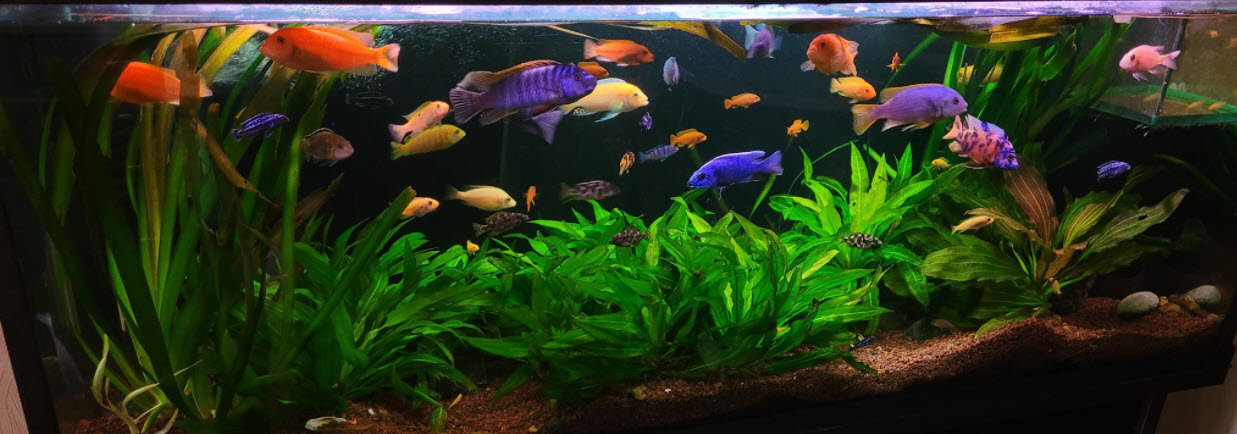
Plants Only Slowly Become Established
Note that a newly set up aquarium should not be fertilized until there are signs the plants are growing and putting out new shoots. This typically takes two to three months. And plants typically die back after addition to a new aquarium.
Many aquarium plants are grown in a greenhouse with only their roots submerged. The leaves are in air, where they grow three to four times faster. The leaves which are grown in air typically die back when submerged and are replaced by new leaves. This takes some time.
Amazon swords as purchased in the store typically have rounded leaves which is the way they grow in air. When placed in an aquarium Amazon sword rounded leaves die and are replaced by pointed leaves. This leads to all sorts of consternation among hobbyists: “My plants are dying. Why is this happening? What am I doing wrong?”
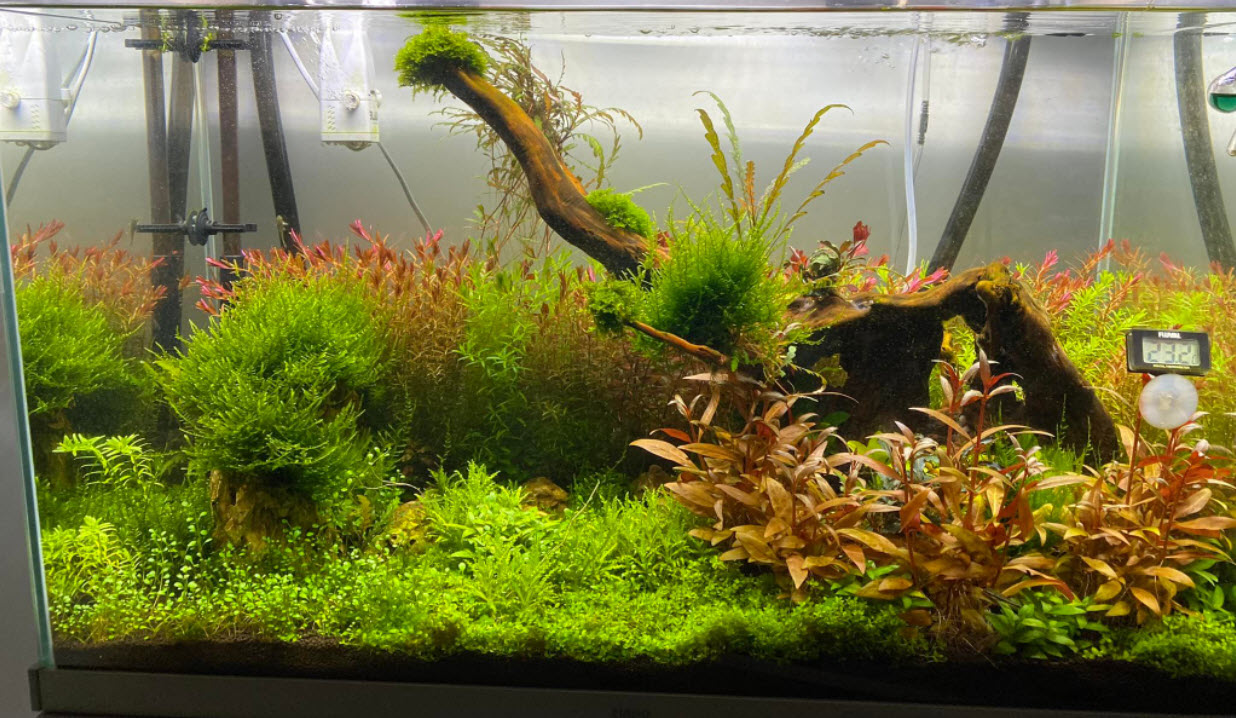
Planted aquariums REQUIRE three things:
.
Patience, Patience and Patience
.
A very common scenario is that a hobbyist sets up a planted tank and immediately starts fertilizing the plants “to get the fastest possible plant growth“. The hobbyist then gets a huge amount of algae growth and the algae kills the plants by smothering them. It is very important to start a very small amount of fertilizing only when the plants become established and putting out new shoots. Then VERY SLOWLY ramp up the level of fertilizer. The following is an eight month old tank where the hobbyist SLOWLY ramped up the fertilizer.
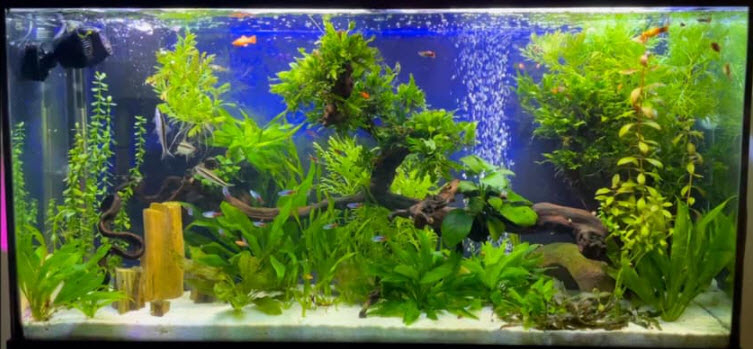
The following is an aquarium where the hobbyists started fertilizing immediately upon adding plants to the tank:
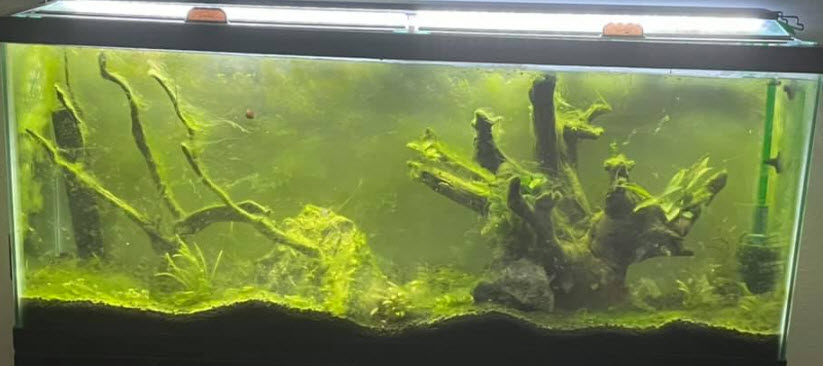
The conclusion here is pretty obvious.
And do not be surprised if one gets algae growth. It is by far the most common problem in newly set up planted aquariums and one just has to “weather the storm”. Expect to lose some plants. Most tanks lose easily 50% of the plants in the first two months of operation. The plants are “shocked” by the transfer to the new tank and they often just die from shock, just like new fish. But plants take weeks to die. And smothering algae will claim some plants.
And one can over fertilize. The following aquarium had been up for a month and a half. The plants were NOT yet established and growing. But the hobbyist was giving the tank the full recommended dosages of Aquarium Co-op Easy Green and Easy Iron. This result was totally predictable.
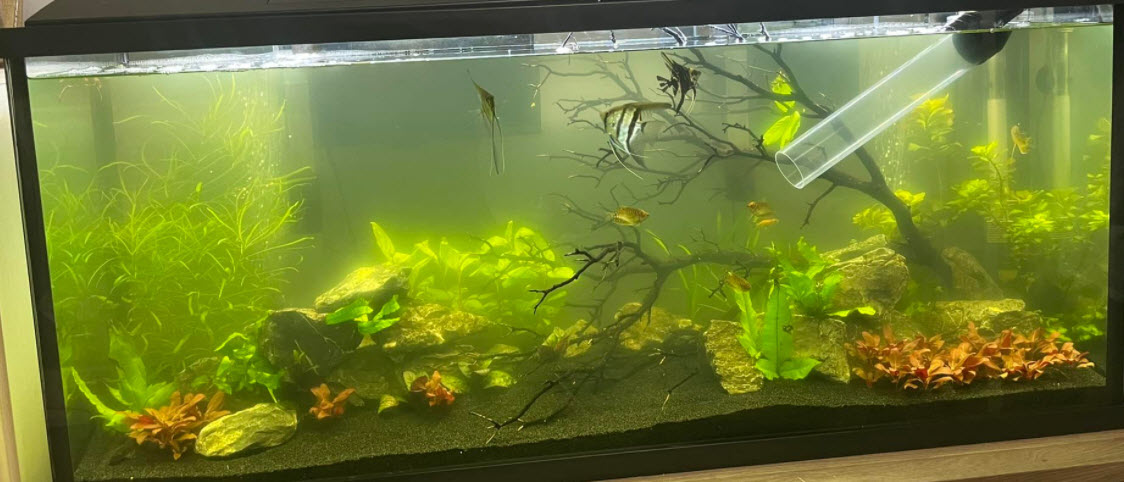
The Number of Plants in any Aquarium
If one is using a decorative plant approach where one is planting something other than the easy Amazon swords, Java ferns or Java moss, it is TYPICALLY BUT NOT ALWAYS very important to plant an aquarium with a LOT of plants. There TYPICALLY BUT NOT ALWAYS needs to be a plant of some sort every three inches.
To illustrate, a 20 gallon aquarium is 24 x 12 x 16. This will TYPICALLY BUT NOT ALWAYS require 5×3 or fifteen plants evenly spaced every three inches. Plant a carpeting plant like dwarf sag in the foreground. Plants which are thriving produce some sort of a “cloud” on their leaves and in the immediate vicinity which keeps algae at bay. But the whole aquarium TYPICALLY BUT NOT ALWAYS needs to be covered in plants or it doesn’t work. More about that in this link:
16.2.5. The Algae War
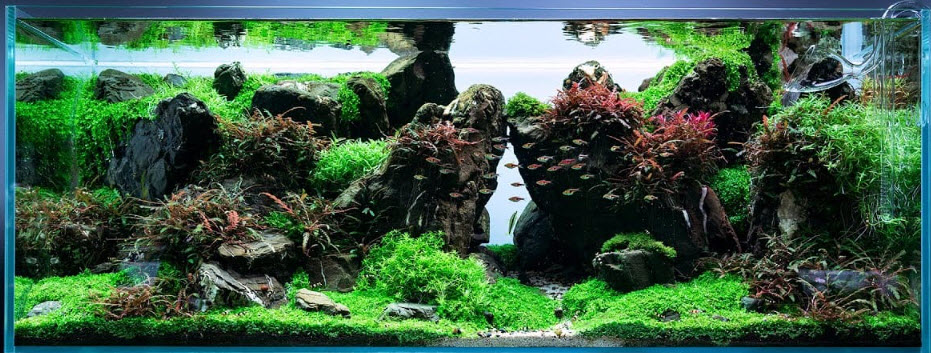
If you have a larger tank this can get a bit daunting. A 75 gallon four foot by foot and a half aquarium will require 75 plants. At $8 a plant that if $520, which is a bit steep. The best way to avoid this cost is to grow your own plants outside the aquarium and only plant them when you have a lot of them. More on propagating plants in this link:
15.12. Propagating Plants
I use the terms “TYPICALLY BUT NOT ALWAYS” freely here as there are some aquariums on social media which violate this concept quite successfully. As I keep emphasizing, Mother Nature is very flexible and it is possible to succeed with some mixtures of plants and planting schemes which are quite “abnormal”.
Algae and Higher Plants: Getting a Good “Balance”
In any given aquarium there are typically hundreds if not thousands of species of algae that have come in on plants or in the air. Algae can reproduce very rapidly (ever seen a “green tank” appear over the span of two days?). So chances are very good that one or more of these these algae will to do well even when the many parameters in any planted aquarium are not “balanced”. But higher plants are much more finicky and there is not the variety of species in the aquarium that algae enjoy.
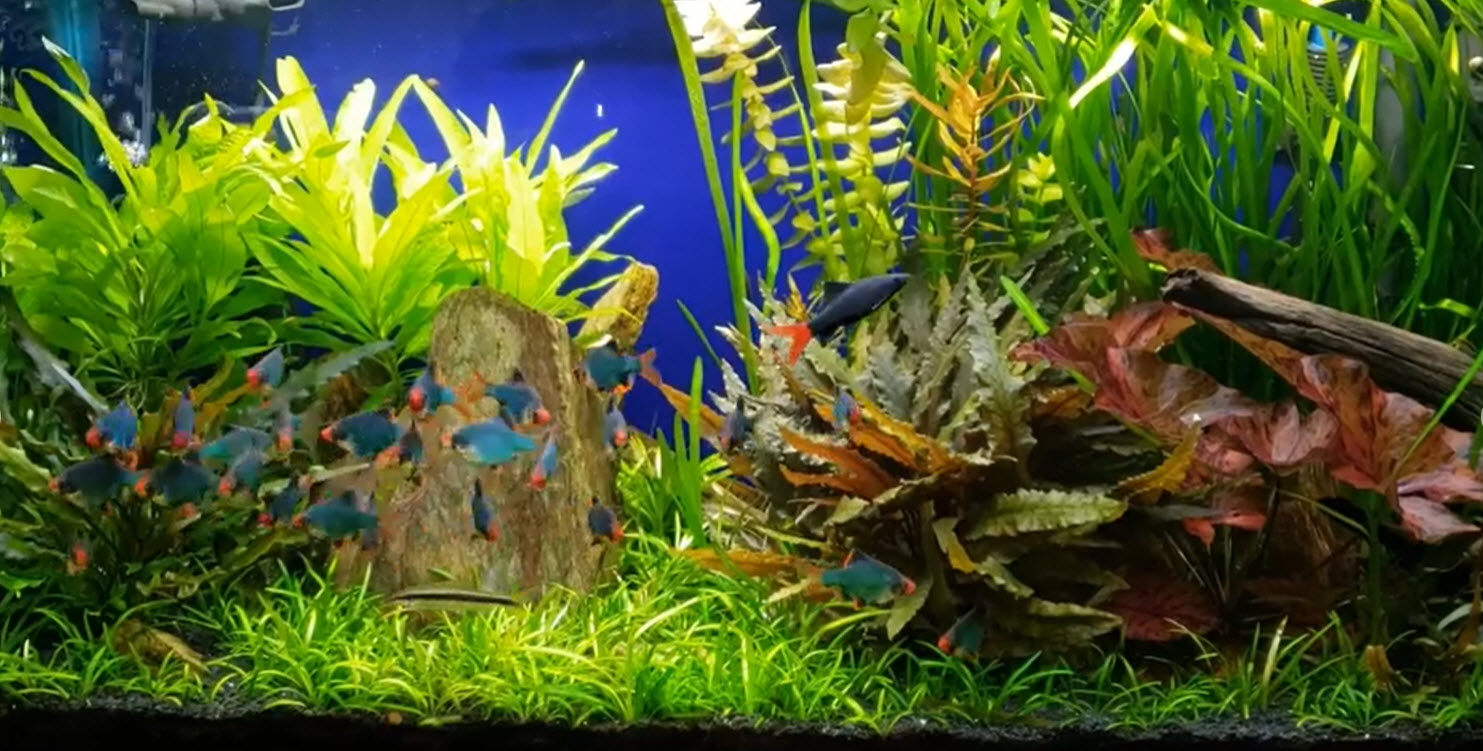
If you put a high-powered LED light on a Walstad aquarium TYPICALLY BUT NOT ALWAYS the higher plants will be smothered very rapidly by algae. By the same token, put a very low powered light on the tank and TYPICALLY BUT NOT ALWAYS you will also get smothering algae growth. Higher plants TYPICALLY BUT NOT ALWAYS require a balance. The right amount of light, the right amount of carbon dioxide, the right amount of nitrogen, the right amount of phosphorus, ad. infinitum. Getting this balance TYPICALLY BUT NOT ALWAYS takes a lot of time and patience.
I use the term “TYPICALLY BUT NOT ALWAYS” here because some hobbyists are quite successful just sticking a few plants into a fish aquarium and letting Mother Nature do her thing.
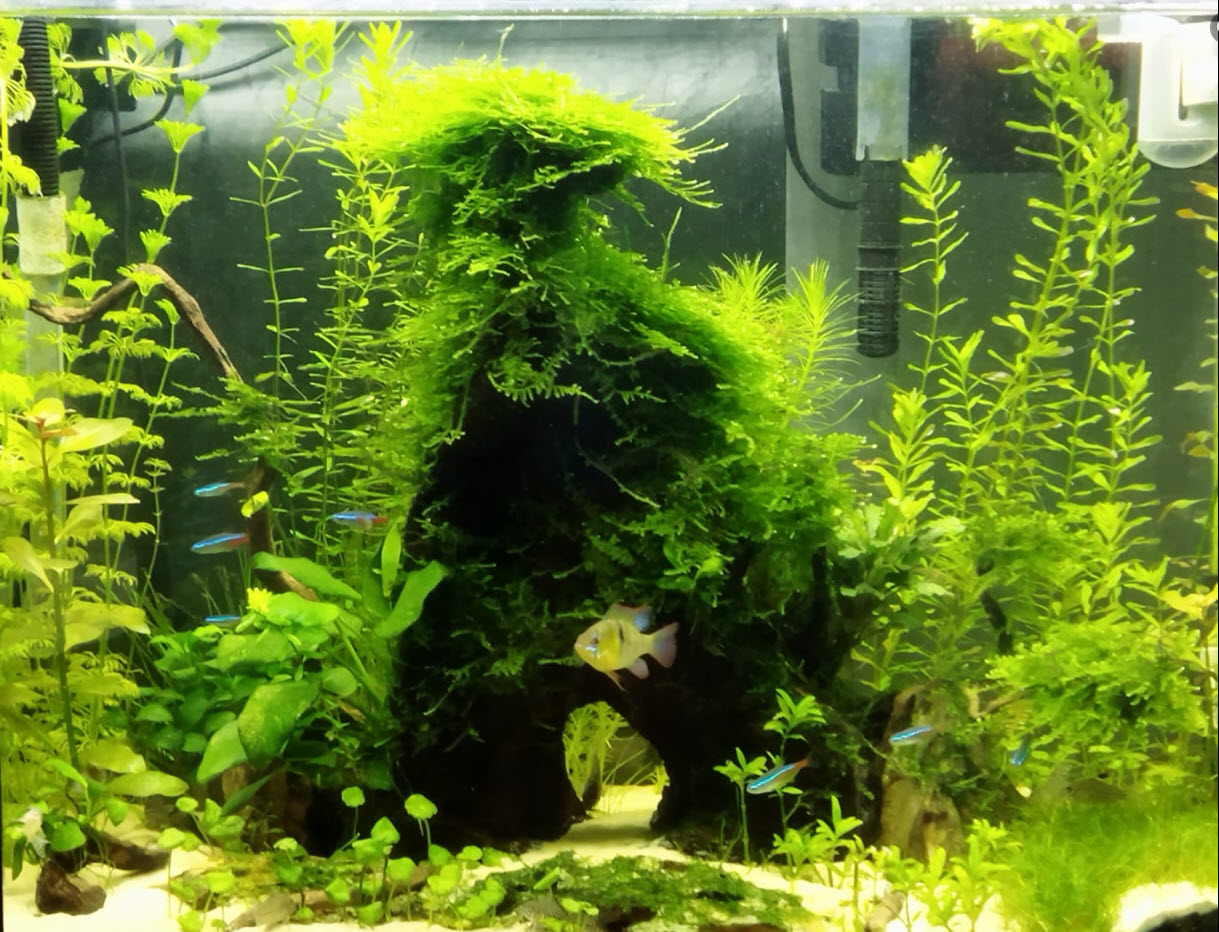
Cyanobacteria
Many aquariums I see with algae problems don’t have an algae problem. They have a cyanobacteria problem. Cyanobacteria are a green bacteria which often closely mimic the look of real algae. Since these cyanobacteria are not plants, they like different things than algae. They love warm still water with lower oxygen content. Oftentimes “algae” will go away with increased water flow over the substrate, lower temperatures and greater aeration. And NEWSFLASH: tropical fish do just fine at 70 degrees.
To illustrate the problem that this cyanobacteria present: in a low tech planted tank cyanobacteria can be made to go away with aeration, water flow and lower temperatures. Several common ways to decrease the amount of say blackbeard algae is to decrease the aeration, decrease the water flow and increase the temperature. This is exactly the opposite of the cyanobacteria approach.
Most plants go relatively dormant at 78 degrees and start dying at 85 degrees. So go for cooler temperatures with a planted aquarium. And of course one can’t increase aeration without decreasing carbon dioxide levels which can mean the plants die. So cyanobacteria control can be difficult.
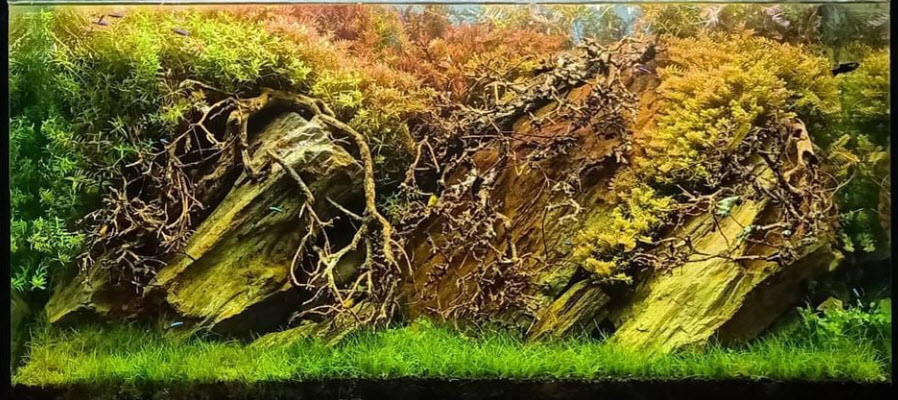
Algae Control in General
To control “algae” with a planted tank go up and down with one variable at a time and see what happens over a time span of a month or so. Do this with:
- Carbon dioxide levels (typically 60% of the “problem”)
- Lighting (typically 30% of the “problem” )
- The duration of the light
- Intensity of light levels
- The spectrum of the light
- Fertilizer Levels (surprisingly unimportant most of the time)
- Nitrogen levels
- Potassium levels
- Phosphorus levels
- Iron levels
Obviously this process requires a LOT of patience. Coming up with the right formula for a planted aquarium can be much more challenging than a fish only aquarium.
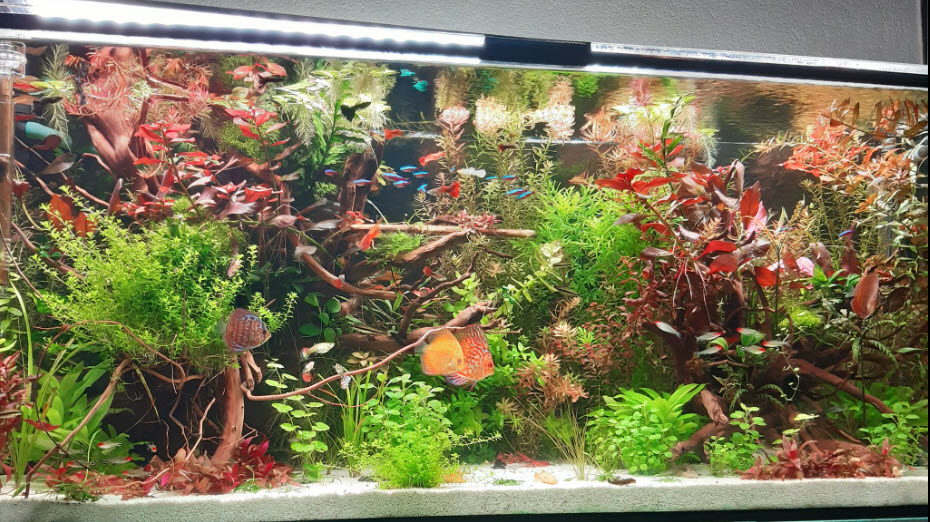
Note that the most important variable here is carbon dioxide. Higher plants love CO2 while algae seem to hate it. Vascular plants need carbon dioxide to make the cellulose that surrounds each cell and forms the framework of the plant and its stems, roots and leaves. The algae have no such requirement and have thin walls and little cellulose. Thus algae need far less CO2 than do vascular plants.
If one has a low tech soiled tank with no carbon dioxide injection one can increase the CO2 level with reducing the surface water movement and aeration. In higher tech “chemical” planted aquariums one can simply increase the CO2 level. With no soil and no CO2 system just add a whole lot of driftwood or add a Hau bottle. Vascular plants TYPICALLY BUT NOT ALWAYS need some source of extra CO2.
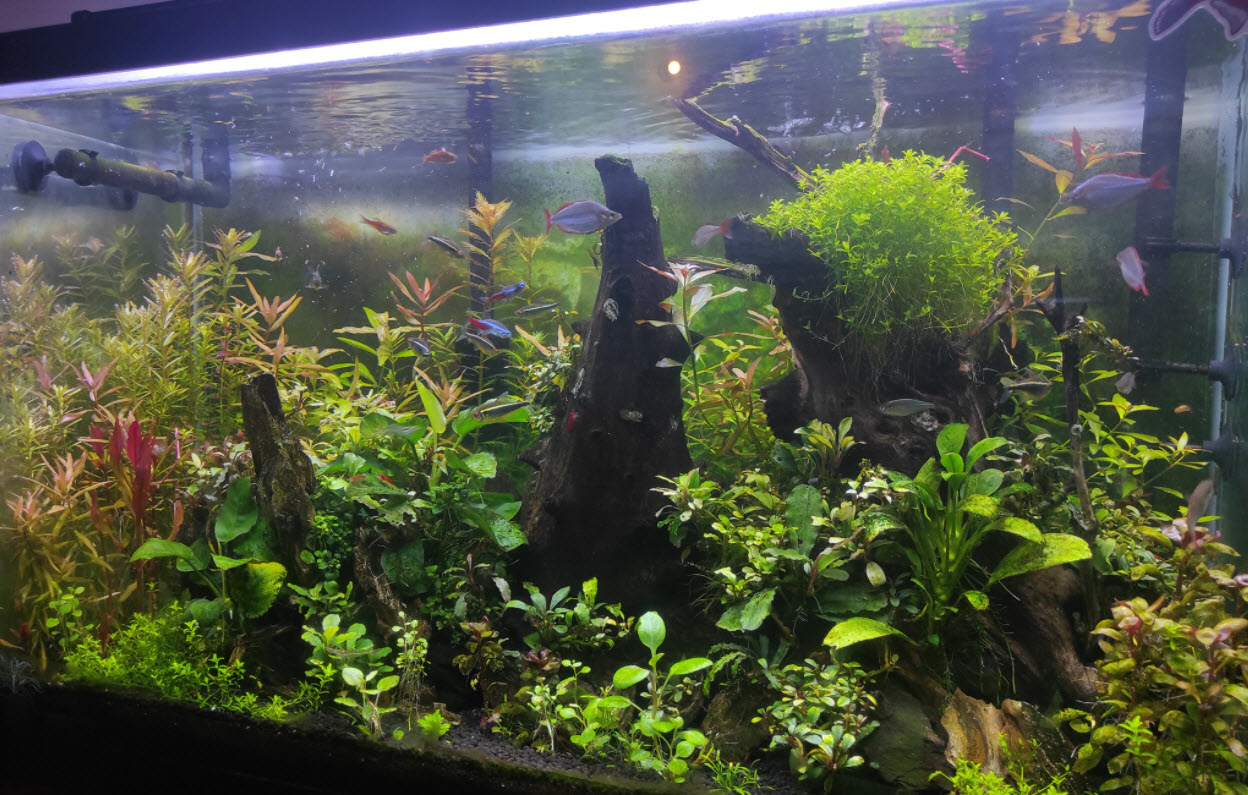
For more about algae in a planted aquarium go to these links:
16.1. Controlling Algae
16.2.2. Controlling Algae in the “High-Tech” Planted Aquarium
16.2.3. Controlling Algae in the “Low-Tech” Planted Aquarium
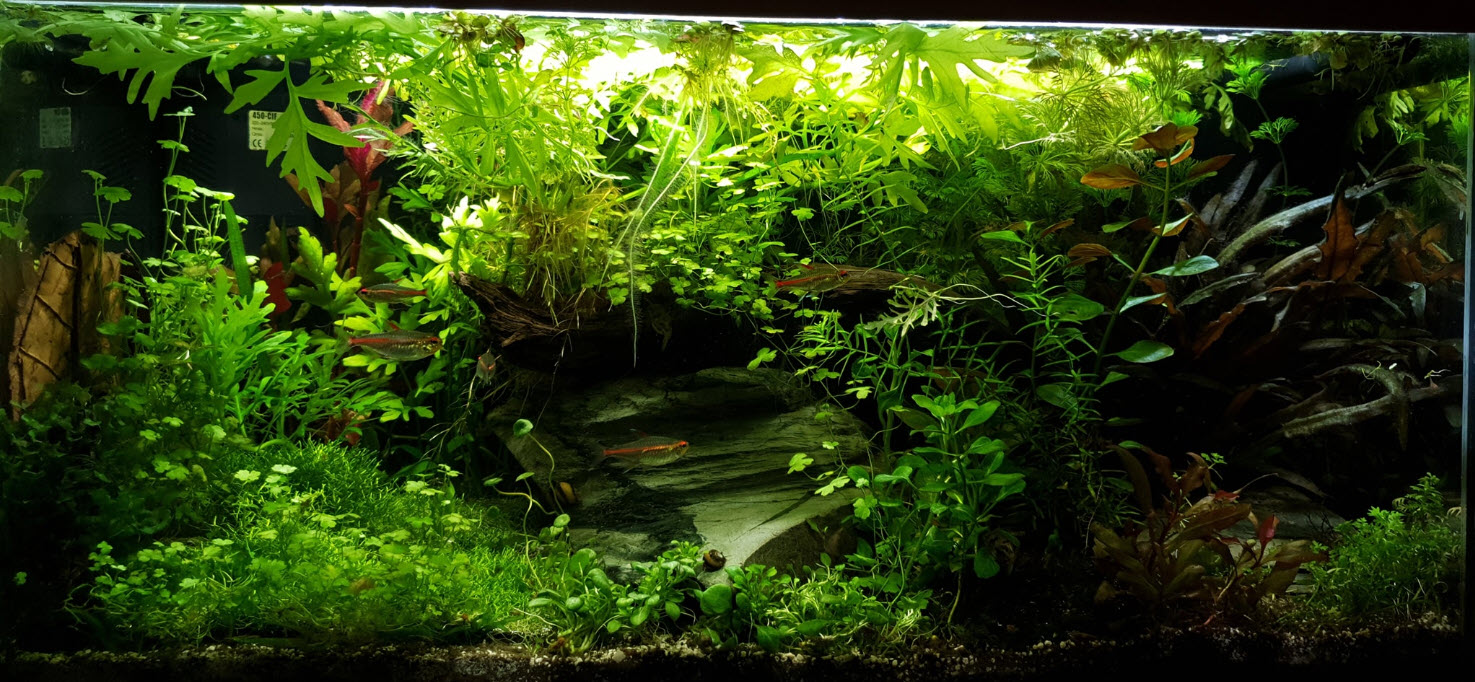
In order to get the best growth of rooted plants without algae it is best to use homemade root tabs. For more information on this go to this link:
15.5. Fertilizing the Planted Aquarium
Thriving plants will generally out compete algae and kill the algae. But coming up with a formula is very difficult as there are trillions of plant, water and algae combinations possible. What works for one combination will not work for another. So when someone looks at a picture of algae in a planted tank on social media and says something like “Just reduce the lighting and the algae will go away” I just have a little chuckle. Sometimes this will work and sometimes it won’t.
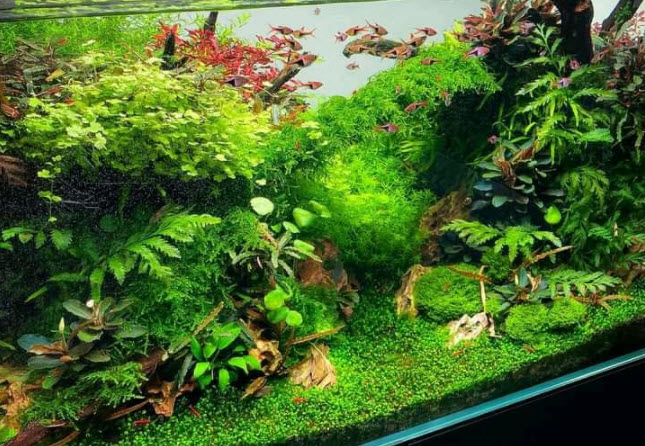
Plants
Selecting the plants is up to the individual. There are many options and whole books written on the subject. Then there are some plants like Anubias, Amazon sword, Java Fern and Java moss which are very easy to grow. Note that as a rule of thumb, the greener the plant the easier it is to grow. Plants with red, maroon or light green yellow leaves are more difficult to grow.
Also note that one should never buy plants because you “like the look of them” in the store. I’ve seen some selections of aquarium plants in the large box stores where easily 50% of the plants were terrestrial plants from the garden which will die in the aquarium.
These terrestrial plants look better than the “real” aquarium plants and thus sell better. These terrestrial plants also are cheaper and faster to produce. Love the profit motive. Make a list of the plants you want after looking them up on line or reading about them in books. Then ONLY buy those plants which are in your list.
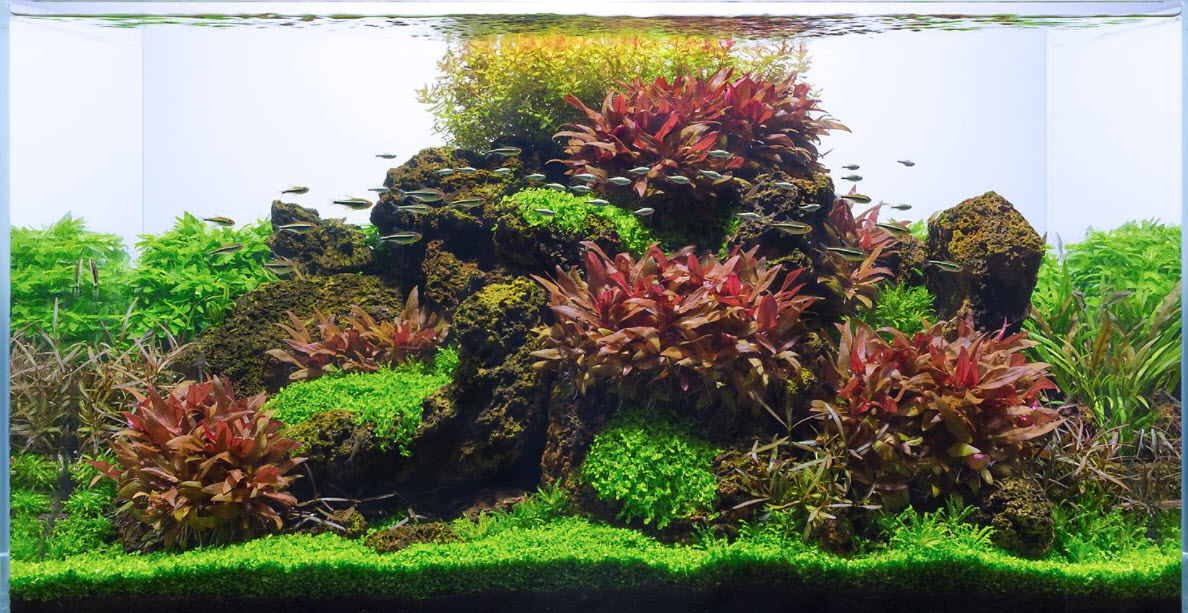
Here are some plants which are “easy”:
- Undemanding, rooted
- *Amazon Swordplant (Echinodorus bleheri and Echinodorus amazonicus)(dies back initially)
- *Java fern (Leptochilus pteropus, synonym Microsorum pteropus)(likes the open substrate or epiphytic)
- *Anubias barberi forms (likes bulbs to be above the substrate or in an open substrate, very slow)
- Cryptocoryne (many forms, dies back when planted, then comes back)
- Bucephalandra (“Buce”, many very attractive brown forms, slow)
- Cabomba (can be a floater or rooted)
- Bacopa caroliniana (needs lots of light or becomes “leggy”)
- Rotala rotundifolia (needs lots of light or becomes “leggy”)
- Vallisneria (many varieties)
- Undemanding Carpet Plants, rooted
- Pygmy Chain Sword (Echinodorus tenellus)
- Pearlweed (Hemianthus glomeratus)
- Dwarf Baby Tears (Hemianthus callitrichoides)
- Undemanding epiphytes which like to be attached to rocks and wood
- *Java moss (Taxiphyllum barieri)
- Susswassertang (“round-leaf Pellia“), a slow grower, expensive but worth it, needs to be attached.
*VERY VERY easy
Note the speed with which most of these plants grow is dependent largely on the amount of CO2 in the aquarium. In a low-tech setup with no CO2 and no soil (adds CO2) most of these plants will grow very slowly.
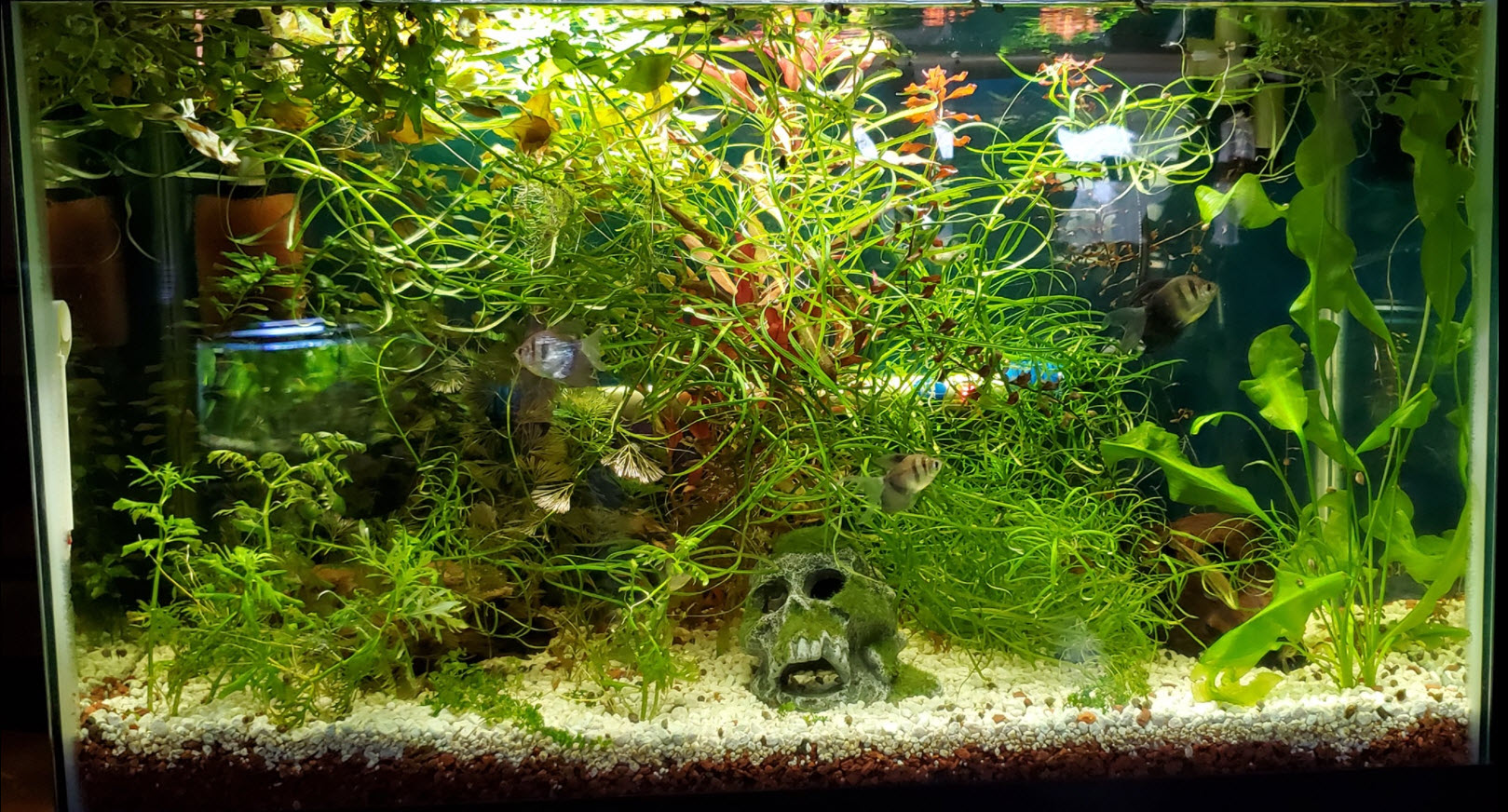
Then there are floating plants. I do not like the look of floating plants and I do not use them in my decorative aquariums. But many love them. Here are some floating plants that are easy:
- Fast-growing plants which typically float in the upper layers of an aquarium
- Elodea (Anacharis), Egeria, and Hydrilla are very similar appearing floating plants
- Riccia sp.
- Milfoil (Myriophyllum sp.)(note this plant smells bad!)
- Water Sprite (Ceratopteris thalictroides, can be emergent)
- Water Wisteria (Hygrophila difformis, very similar to water sprite)
- Hornwort (Ceratophyllum demersum)
- Undemanding emergent plants (“floaters”, they float on the surface of the aquarium water with the leaves exposed to the air)
- Water Lettuce (Pistia stratiotes)
- Duckweed (grows so fast some consider it a noxious weed)
- Salvinia
- Azolla
- Amazon Frogbit (Limnobium laevigatum)
Here is one fine example of floating plant use:
-
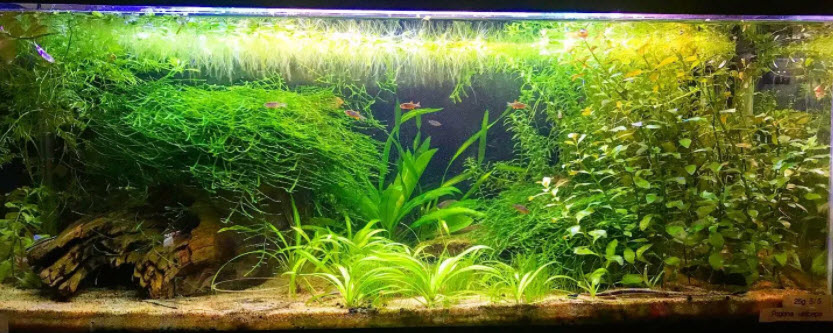
Emergent Plants in an Aquarium The Water For Planted Aquariums
There is a common scenario with planted aquariums where some individual wants to grow some exotic plants in among their other plants in the aquarium. They do a Google search and find the “perfect” water parameters for the plant. So they buy an RO system, buy some chemicals, and begin adjusting pH, TDS, KH and GH to “perfect” levels. They do this for six months to a year and then find it is just too much. They start using their tap water. And the exotic plant does fine.
Do not worry about pH, TDS, KH and GH. Just use what is coming from your tap. The only exceptions are very soft water (GH less than 2) or very high pH water (pH greater than 8.0). Trying to play chemist or getting the “perfect” water parameters is rarely productive. Only if one is entering competitions with a high tech style aquarium is such a program even desirable.
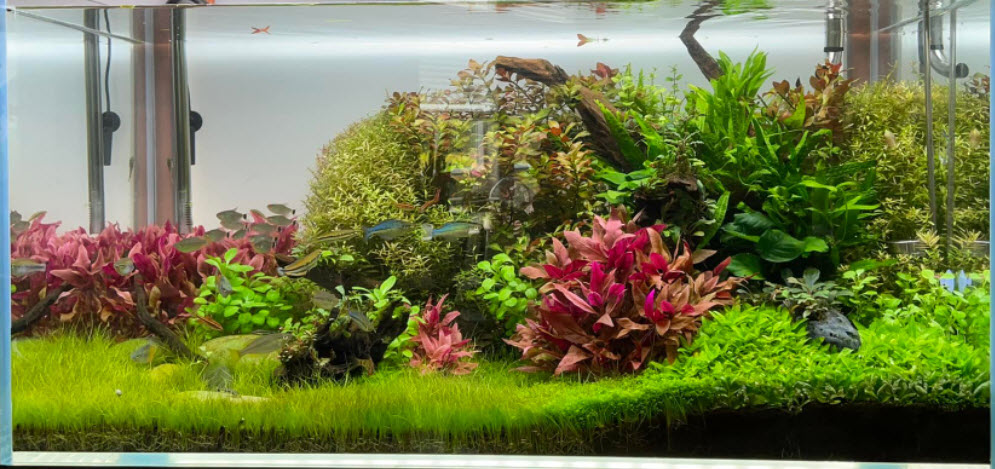
High Tech Planted Aquarium If you do want to get to “perfect water” for most plants use plaster of Paris (calcium sulfate) and Epsom salts (hydrated magnesium sulfate) in equal quantities to achieve a GH of 3 to 6 with a pH of 6.8 to 7.6 when measured first thing in the morning before the lights come on. This is where most plants do well.
If you have very hard water with a pH over 8.0 the only plants which will flourish are Vallisneria, Cryptocoryne, Anubias, Java fern, Cabomba, Sagittaria, Hydrocoytle, Limnophila, Ludwigia, Bacopa, Pogostemon, Hygrophilia and all the emergent plants. This might have to do with gaseous CO2 getting tied up in high pH situations. Some plants can pull CO2 from bicarbonate (HCO3) and carbonate (CO3) and some plants cannot do that.
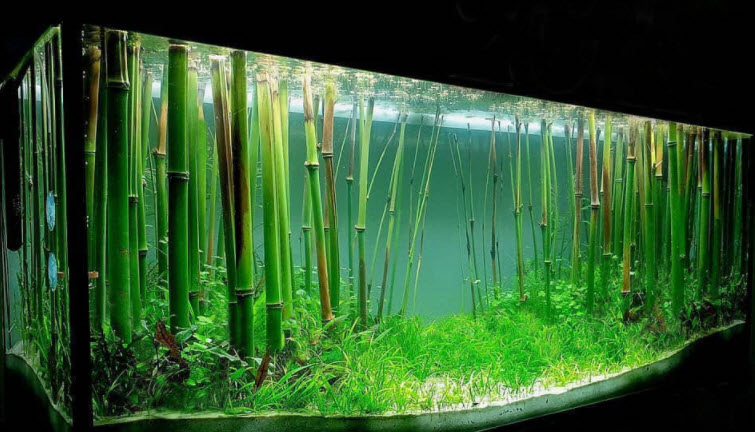
Planted Aquarium Books
If you want to set up a planted aquarium there are many books about a planted aquarium. The “bible” for “natural” low tech planted aquariums is Diana Walstad’s “Ecology of a Planted Aquarium”. Another useful book if one can handle the bad translation is the book “The Optimum Aquarium”.
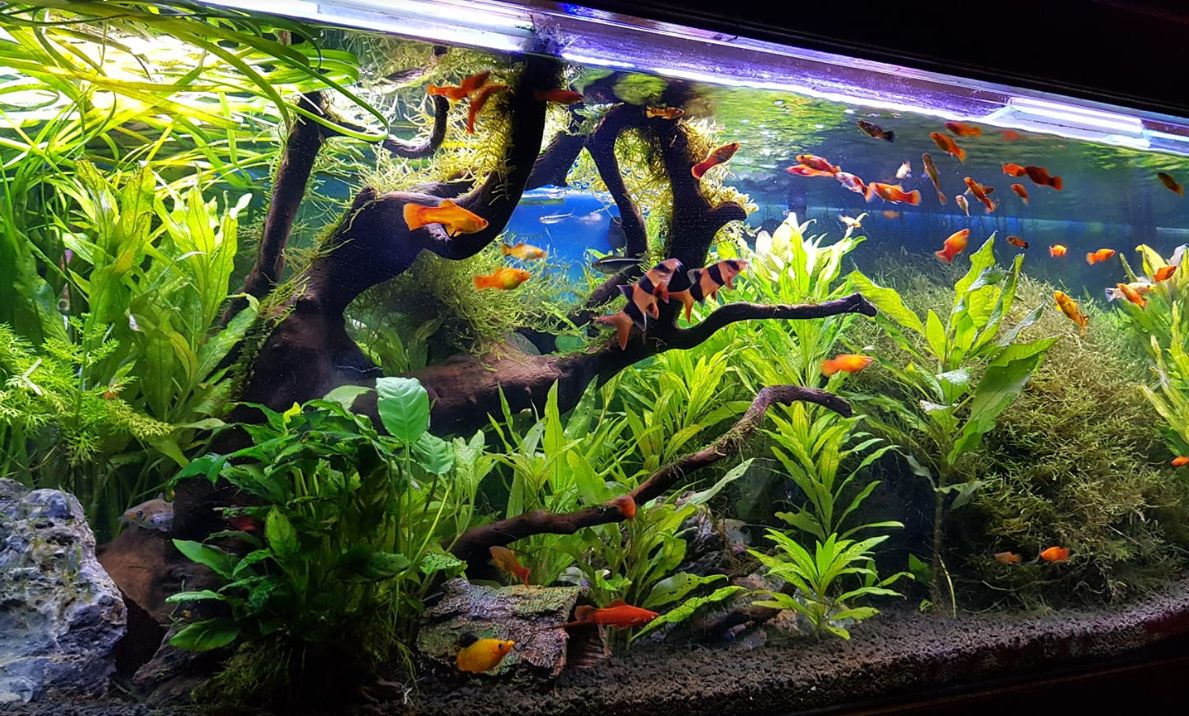
Heavily planted aquarium with a few fish A Good Example
One very good YouTube channel who had big problems with a planted tank set up was Irene at “Girltalksfish”. This is an EXCELLENT channel. Subscribe to her channel for $5 a month if you are interested. It is well worth the money. She set up a “low tech” planted aquarium that had the following characteristics:
- Substrate: 2 inch commercial Aquasoil
- Fertilization: Heavy with Aquarium Co-op soluble (20 ppm nitrate), Co-op root tabs and Seachem potassium
- Carbon Dioxide: No CO2, not even from soil
- Lights: Fluval Planted Tank lights at 100% for 14 hours
- Filter: air operated sponge filters
- Aeration: air stones in sponge filters, heavy
- Water movement: air stones were doing lot of movement
- Fish: Small number of small fish
Initially Irene had far too much lighting and this gave her a lot of algae. So she cut back on the lighting to six hours at 30%. This controlled the algae somewhat. Then she had leave holes from too little potassium (one large Java Fern plant was rapidly removing everything she added). And even then certain plants did not do too well. She ultimately stopped her air stones and shelled out about $300 for a carbon dioxide inject system. Her plants then took off and the algae became manageable.
This is all anecdotal and not a controlled experiment but Irene knows her stuff and her experience is instructive. It closely parallels several of my planted aquarium experiences.
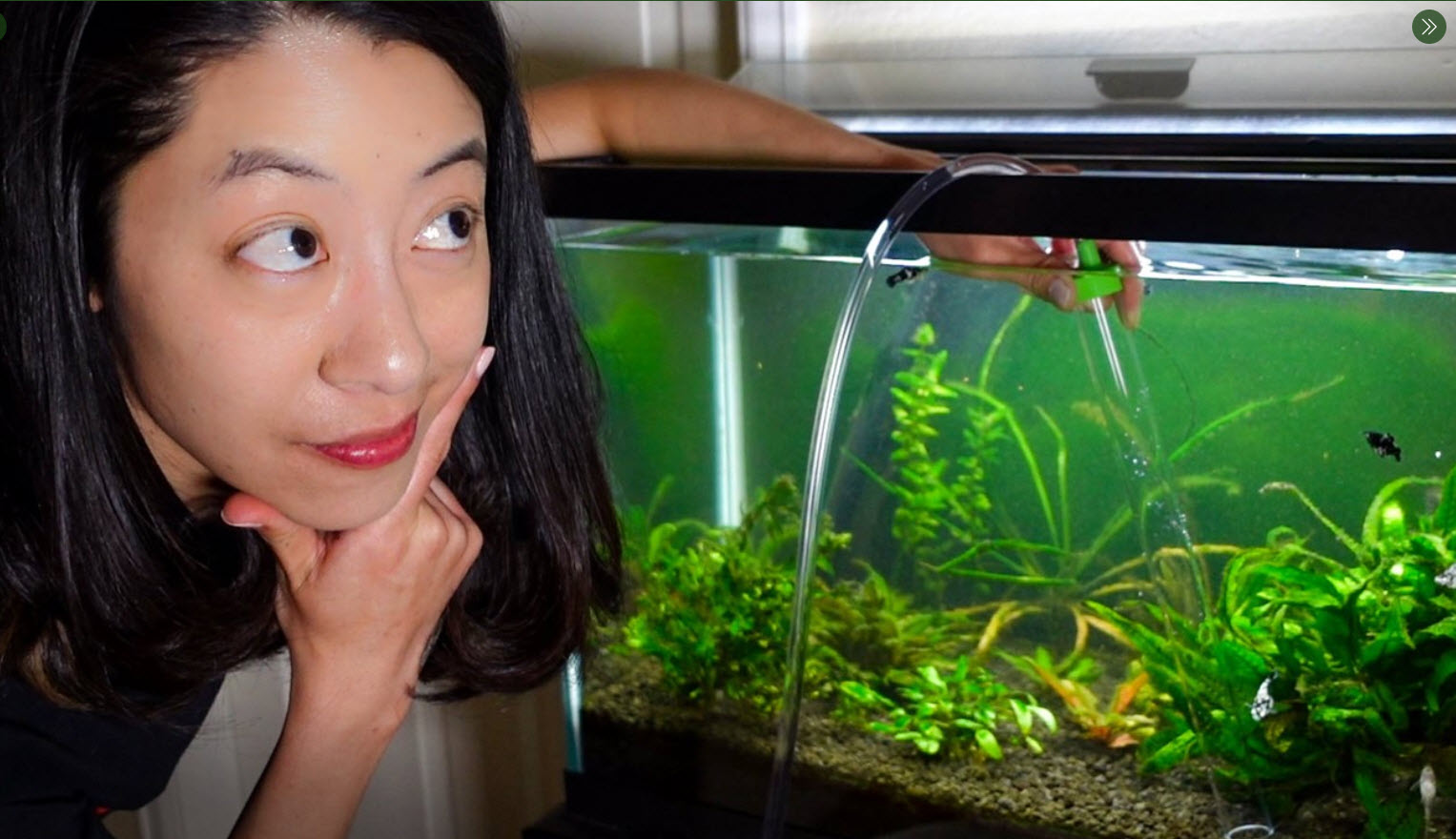
Irene at Girltalksfish Low Tech CO2 System for Aquariums
There is a low cost, low tech system which adds considerable CO2 to an aquarium. The details of this system can be found at this link:
15.6.1 Low Tech CO2 Aquarium System
Planted Aquariums in Depth
The following sections will give you some general guidelines on the easiest ways to set up a beautiful planted aquarium:
15. Planted Aquariums
15.2. Fish for Planted Tank
15.3. Fish Limitations
15.4. Types of Planted Aquariums
15.5. Fertilizing
15.6. Carbon Dioxide
15.7. Substrates for Planted Aquariums
15.8. Walstad Aquarium
15.9. High-Tech Planted Aquarium
15.10. Hybrid Planted Aquariums
15.11. Many Fish Many Plants
15.12. Propagating Plants
15.13. Hua Aquariums
15.14 Low Tech Planted Aquariums
15.15. Sterilizing Plants
15.16. “Natural” or “Balanced” Aquariums
.
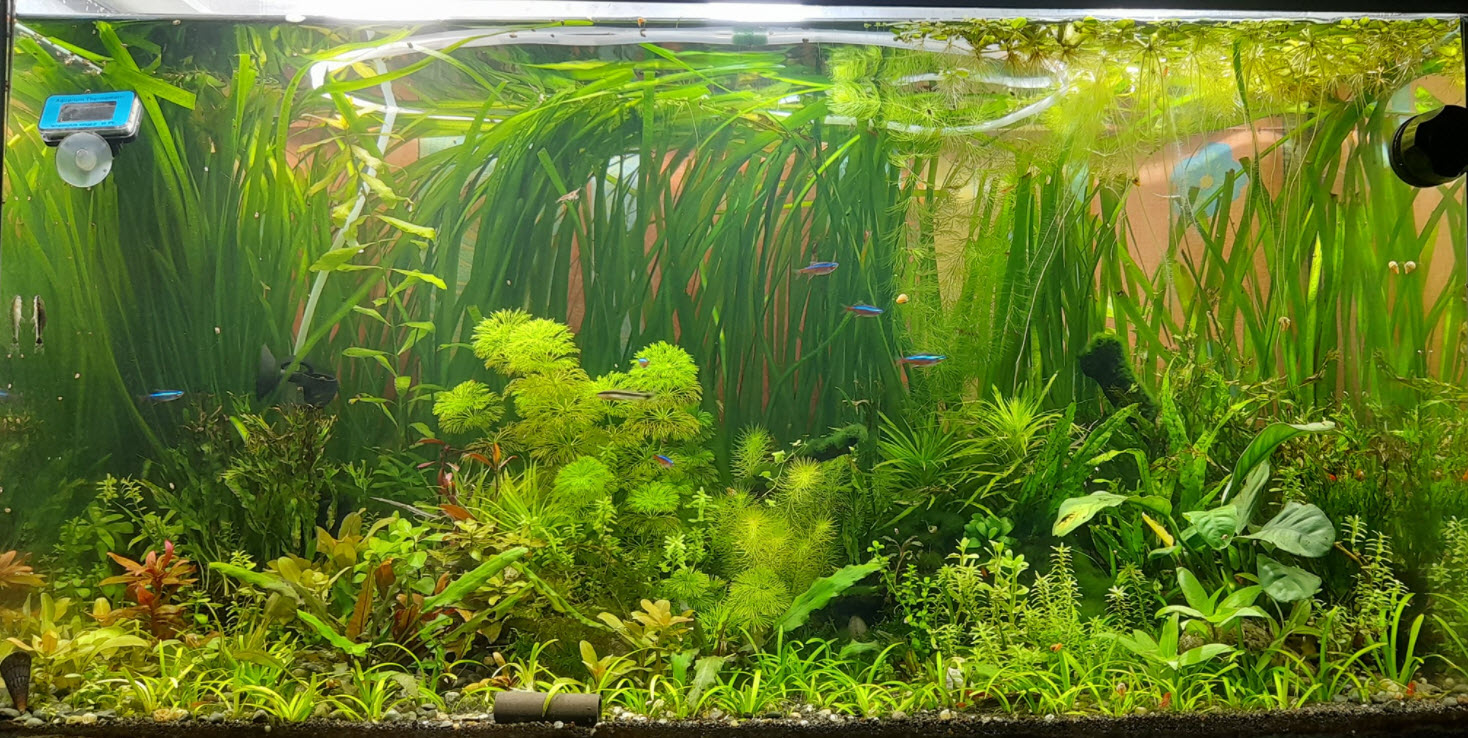
Planted Aquarium Return to Planted Tank Menu
.
Aquarium Science Website
The chapters shown below or on the right side in maroon lead to close to 400 articles on all aspects of keeping a freshwater aquarium. These articles have NO links to profit making sites and are thus unbiased in their recommendations, unlike all the for-profit sites you will find with Google. Bookmark and browse!
.
Reader Interactions
Comments
Leave a Reply

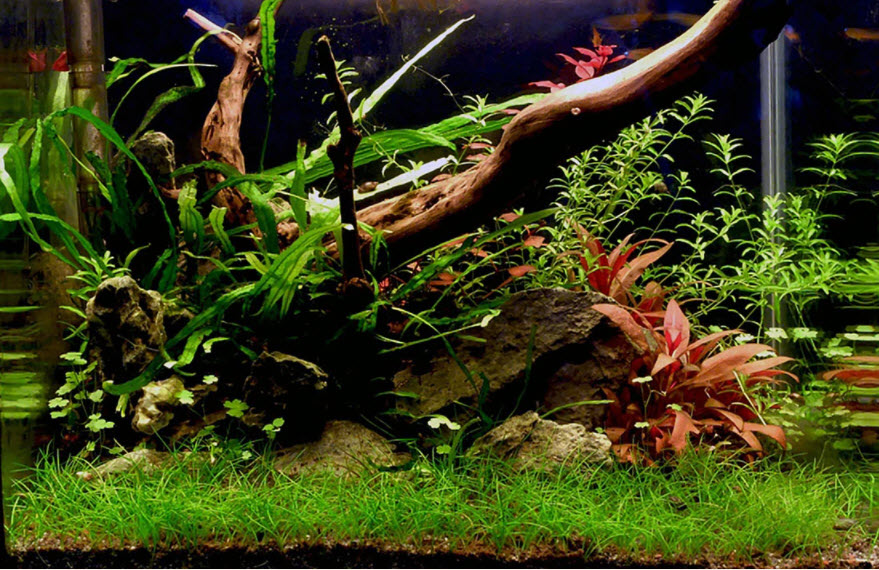
Dave says
In reply to Sagi ….. It has been my experience that plants benefit from a “settling in” period of one to two months. My limited experience is also that algae LOVE immediate fertilization.
Sagi says
Hi, on establishing a new low tech planted aquarium with the setup of no co2, low-moderate light, no fish,..still no Fertilization whatsoever till mature plants?
William McDowell says
Great article. In my experience very low CO2 (below 10 ppm) and inadequate light strength are the chief causes of excessive and unsightly algae in a planted aquarium. With low CO2 and inadequate light intensity lower plant leaves start to die, they release ammonia and hey-presto algae seizes the environmental niche. However high Phosphate and or Nitrate levels can be an issue, particularly if the tap water is high in such elements and sometimes, rarely, trace elements can be deficient and in the summer temperatures can be too high for plants and algae again filled the environmental niche. Low light plants are low light plants however, and Java fern is challenging to keep pristine in a high tech, high light tank in which red or fast growing stem plants flourish. Keep up the great work, I am going to try at some point the wood pellet and potash etc., hybrid tank setup.